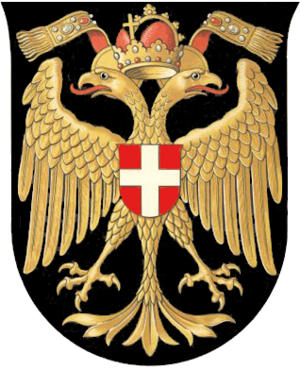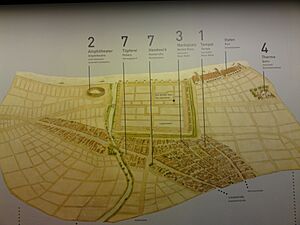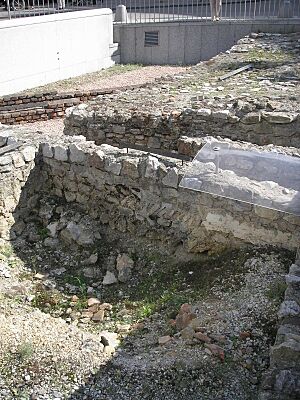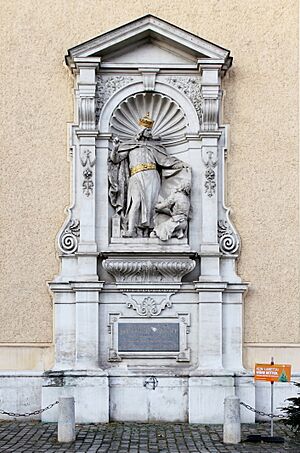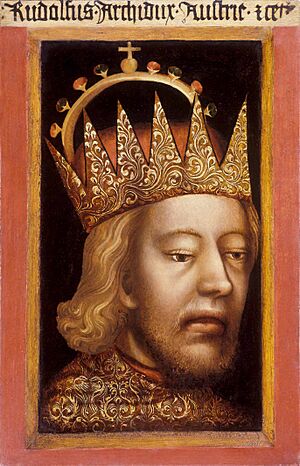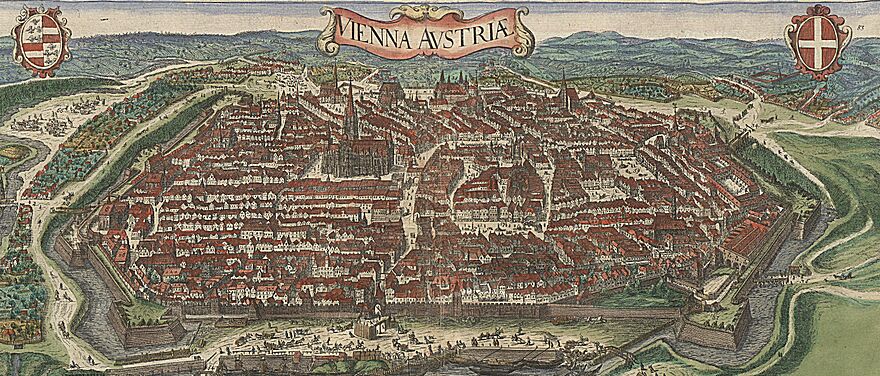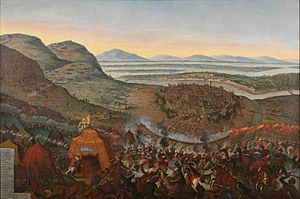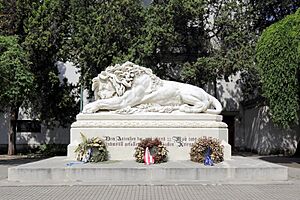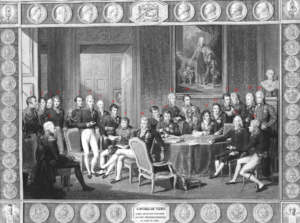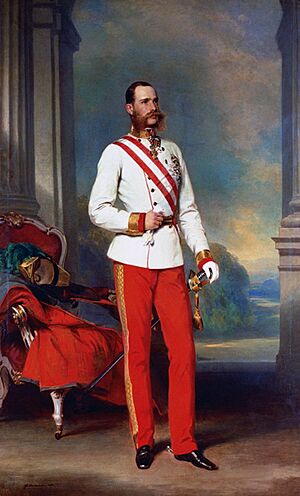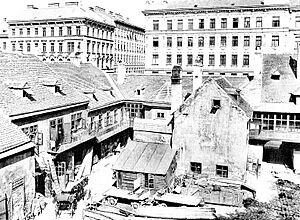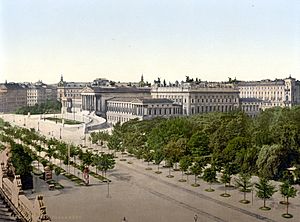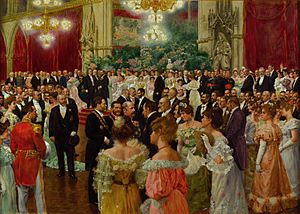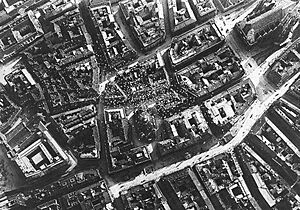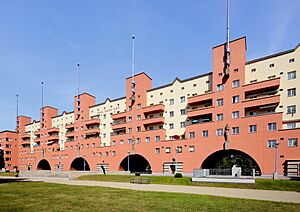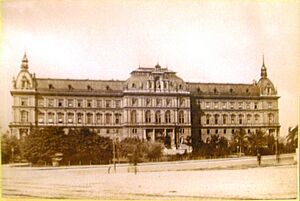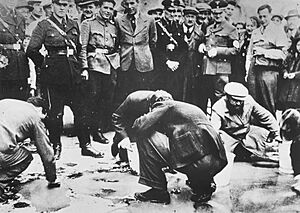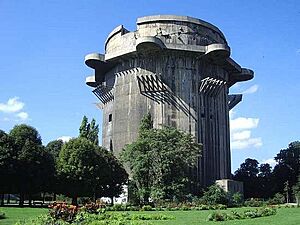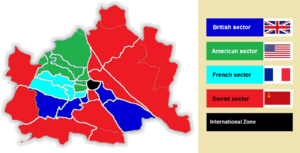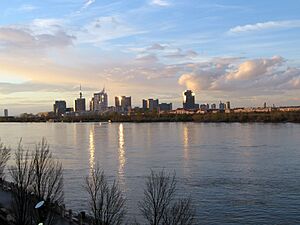History of Vienna facts for kids
The history of Vienna is very long and interesting! It started when the Roman Empire built a military camp where Vienna's city center is today. This Roman settlement was called Vindobona. Vienna grew into an important trading city by the 11th century. It became the main city for the Babenberg family and then for the Habsburg family. Under the Habsburgs, Vienna became a major cultural center in Europe. In the 19th century, as the capital of the Austrian Empire and later Austria-Hungary, it was one of Europe's largest cities for a while. Since World War I ended, Vienna has been the capital of the Republic of Austria.
Contents
How Vienna Began: Roman Times
The name Vindobona comes from an old Celtic language. This tells us people lived here even before the Romans arrived. The Romans built a military camp in the 1st century. This camp was located where Vienna's city center is now. An army group called Legio X Gemina stayed there. In 212, the settlement became an official Roman town. Even today, some streets in the First District follow the lines of the old Roman walls. The Romans stayed in Vienna until the 5th century.
Roman Vindobona was on the edge of the empire. So, it faced a lot of trouble during the Migration Period. There are signs that a big fire happened around the early 5th century. But the Roman camp was not completely empty. A small group of people stayed there. The streets and houses of early medieval Vienna followed the old Roman walls. This suggests that parts of the old forts were still standing and used by the new settlers.
Vienna in the Middle Ages
Byzantine copper coins from the 6th century have been found in Vienna's city center. This shows that there was a lot of trade happening. Graves from the 6th century were also found near the Berghof. At that time, the Lombards controlled the area. Later, Slavs and Avars came to live there. Early Vienna was built around the Berghof area.
The first time Vienna was mentioned in writing during the Middle Ages was in 881. This was in the Salzburg Annals. It talked about a battle apud Weniam against the Magyars. But it's not clear if this meant the city or the River Wien.
Babenberg Family Rules Vienna
In 976, the area called Ostarrîchi was given to the Babenberg family. Vienna was right on its border with Hungary. Vienna was an important place for trade as early as the 11th century. In 1155, Margrave Henry II of Austria made Vienna his capital city. In 1156, Austria became a duchy. This meant Vienna was the home of all future dukes. During this time, the Schottenstift monastery was built.
A big event happened during the Third Crusade. King Richard the Lionheart was found and captured near Vienna in 1192. He was captured by Duke Leopold V. This brought a huge amount of money to Vienna. It was about 10 to 12 tons of silver! This money helped Vienna build a mint for making coins. It also helped build city walls around the year 1200. You can still see some parts of these old city walls today near the U-Bahn station Stubentor.
In 1221, Vienna gained important rights. It became a full city and a staple port. This meant that all traders passing through Vienna had to offer their goods for sale in the city. This helped people in Vienna become important traders. Vienna soon built strong trade links, especially along the Danube river and with Venice. It became one of the most important cities in the Holy Roman Empire.
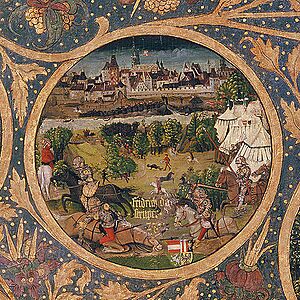
It was seen as a problem that Vienna did not have its own bishop. Duke Frederick II tried to create a bishopric in Vienna.
Habsburg Family Takes Over
In 1278, Rudolf I took control of Austria. He started the Habsburg family's rule. It took some time for the Habsburgs to fully control Vienna. This was because many people still supported the old ruler. There were several revolts against Albert I.
In 1280, Jans der Enikel wrote the "Fürstenbuch." This was the first history book about the city. When the Luxembourg emperors ruled, Prague became the main imperial city. Vienna was less important. The early Habsburgs tried to make Vienna bigger to keep up. Duke Albert II had the Gothic part of the Stephansdom cathedral built.
Rudolf IV of Austria was a very smart leader. He made Vienna's economy strong and people became more wealthy. He is called "the Founder" for two main reasons. First, he started the University of Vienna in 1365. Second, he began building the Gothic nave (main part) of the Stephansdom. This was linked to creating a special church group, like a symbolic replacement for a bishop.
The Habsburg family then had some arguments about who should rule. This led to economic problems and social unrest. There were fights between rich families and skilled workers. In 1408, the mayor, Konrad Vorlauf, was executed.
After Duke Albert V became the German King Albert II, Vienna became the capital of the Holy Roman Empire. Albert is remembered for forcing the Jewish people to leave Vienna in 1421 and 1422.
Finally, in 1469, Vienna got its own bishop. The Stephansdom became a cathedral. In 1485, the Hungarian King Matthias Corvinus and his army conquered Vienna. Vienna became the king's main city until 1490. In 1522, under Ferdinand I, Holy Roman Emperor, important city leaders were executed. This destroyed Vienna's local political system. From then on, the city was directly controlled by the emperor. In 1556, Vienna became the home of the Emperor.
During this time, the city also became Catholic again. It had become Protestant quite quickly. In 1551, the Jesuits (a Catholic religious order) came to Vienna. They soon gained a lot of power in the court.
Turkish Sieges of Vienna
In 1529, the Ottoman Turks attacked Vienna for the first time. This was called the First Turkish Siege. They did not succeed. The city had old medieval walls. It barely held out against the attacks. Then, epidemics and an early winter forced the Turks to leave. This siege showed that Vienna needed stronger defenses. So, in 1548, Vienna was made into a strong fortress. The city got eleven bastions (strong parts of a wall) and a moat (a ditch filled with water) around it. A wide, empty area called a glacis was created around Vienna. This allowed defenders to shoot freely.
These new defenses were very important in the Second Turkish Siege in 1683. They allowed the city to hold out for two months. Then, the Turkish army was defeated by an army led by the Polish King John III Sobieski. This battle was a turning point in the wars with the Turks. The Ottoman Empire was pushed back more and more in the years that followed.
Vienna in the 18th Century
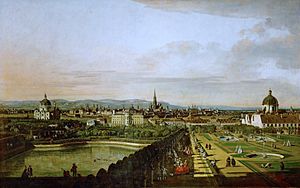
After the sieges, there was a lot of building in Vienna. The city was largely rebuilt in the baroque style. Famous architects like Johann Bernhard Fischer von Erlach and Johann Lukas von Hildebrandt designed many buildings. Most new buildings were in the suburbs. Rich nobility built grand palaces with gardens there. Some famous ones are the Schönbrunn Palace and the Belvedere. In 1704, an outer defense wall was built around these suburbs.
After big plague outbreaks in 1679 and 1713, Vienna's population grew steadily. About 150,000 people lived in Vienna in 1724. By 1790, there were 200,000. The first factories were built around this time. Cleanliness problems started to appear. So, sewers and street cleaning began to develop. Also, the first house numbers were given out. The government postal system started to grow.
Under Emperor Joseph II, the city's government was updated in 1783. Officials were put in charge only of the city. The Magistrate (city council) was created. At the same time, the graveyards inside the city were closed.
Vienna in the 19th Century
During the Napoleonic Wars, French armies took Vienna twice, in 1805 and 1809. The first time, it happened without a fight. French generals tricked the Austrian commander. They said the war was over. So, the French army easily entered the city. People were curious rather than angry.
The second time, the French took Vienna after heavy fighting. Soon after, Napoleon lost his first big battle at Aspern, near Vienna. Less than two months later, his army crossed the Danube again. They fought the Battle of Wagram in the same area. The French won this battle. Austria soon gave up, ending the war.
After Napoleon's final defeat, the Congress of Vienna took place from 1814 to 1815. This meeting redrew the map of Europe. The people at the congress went to many parties. This led to a famous saying: "The congress dances a lot, but it doesn't move forward." These events cost Austria a lot of money.
The first half of the 19th century saw a lot of industrialization. Vienna became the center of the railway network after 1837. The French Revolution of 1848 also affected Vienna. On March 13, the March Revolution happened. This forced the long-serving leader Metternich to resign.
Vienna Grows Under Emperor Franz Joseph I
Vienna expanded in 1850. It included the area within the old outer wall. These suburbs became the 2nd to 9th districts. The old city became the first district. In 1858, the old city walls were torn down. A wide boulevard called the Ringstraße was built in their place. Many grand buildings were built along it. This Ringstraße style still defines Vienna's architecture today. This period reached its peak at the World Exhibition of 1873.
In 1861, Liberals won the first somewhat free elections. After a big flood in 1830, people often thought about controlling the Danube river. This was finally done in the 1860s. The many branches of the Danube were removed. A straight river course was made away from the city center. The branch near the city was made narrower. It is now called the Donaukanal (Danube Canal).
During this time, Vienna's population grew very quickly. This was mostly due to people moving there. In 1910, Vienna had its highest population ever, with over 2 million people. Around 1900, Vienna became a center for Jugendstil (a style of art). This was thanks to artists like Otto Wagner and the Vienna Secession group.
In 1890, the city expanded again. Suburbs beyond the old outer wall became districts 11 to 19. Leopoldstadt was divided in 1900, creating the 20th district. In 1904, Floridsdorf became part of Vienna as the 21st district.
During these years, Karl Lueger was a key figure in city politics. He did a lot for the city. For example, he brought fresh water from the mountains to Vienna. He also created green areas around the city. However, he was also known for his strong anti-Semitism.
Vienna During World War I
World War I (1914–1918) did not directly threaten Vienna. But it caused a lack of supplies. This was because other countries stopped trade. So, there was a shortage of food and clothes. The war cost a lot of money. This led to huge inflation. Many middle-class Viennese lost their savings.
These food shortages led to the 1918 Austro-Hungarian January Strike which started in Vienna. Young members of the Social Democratic Workers' Party of Austria organized meetings against the war in November 1917. On August 9, 1918, Italian planes flew over Vienna. They dropped about 400,000 propaganda leaflets. These leaflets asked the people of Vienna to end the alliance with Austria-Hungary and Prussia.
The First Republic of Austria
The end of the war also meant the end of Austria-Hungary. On November 12, 1918, the Republic of "German-Austria" was declared. This happened in front of the parliament. Many people lived in the capital. Some international newspapers wondered if Vienna could still be a major European city after Austria-Hungary broke up.
In 1921, Vienna became its own state, separate from Lower Austria. The mayor now had the same rank as a state governor. The left-wing Social Democrats were in charge of the city government. "Red Vienna" was seen as a model for other cities. Many famous low-cost housing buildings were built during this time.
However, growing economic problems led to political extremism. The left-wing Republikanische Schutzbund (Republican Protective Alliance) was formed in 1923/24. It was a well-organized armed group. It was opposed by the right-wing Heimwehr ("Home Guard").
In May 1923, the First World Congress of Jewish Women was held in Vienna.
Austrofascism and World War II
In 1927, the Justizpalast (Palace of Justice) caught fire after violent protests. Then, the country's largest bank collapsed. Finally, the parliament was dissolved in 1933. These events led to the Austrian Civil War in February 1934. Engelbert Dollfuß, who was the leader of Austria, banned the Nazi Party, the Communist Party, and the Schutzbund in 1933. In 1934, he also banned the Social Democratic Party. The only legal political group was his own, the Vaterländische Front. Dollfuß created an authoritarian government called Ständestaat.
Nazi Germany Takes Over and World War II
In March 1938, Nazi Germany took over Austria. This was known as the Anschluss. Adolf Hitler was welcomed with excitement in Vienna. He gave a famous speech where he welcomed his homeland into the Reich. Hitler's anti-Jewish policies were popular in Vienna. There had been a lot of anti-Semitism there in the early 20th century. Right after the Anschluss, Jewish people in Vienna faced violence. During the Reichskristallnacht on November 9, 1938, synagogues (Jewish places of worship) were destroyed.
In 1938, Vienna expanded greatly. 91 nearby towns were added to the city. This made Vienna the city with the largest area in the Third Reich. During the war, Vienna had 12 smaller camps of the infamous Mauthausen-Gusen concentration camp.
By 1943, Allied planes began bombing Vienna. Large flak towers (anti-aircraft towers) were built in Vienna to defend against these bombers. These huge towers are still standing today. They are so strong that destroying them would damage nearby buildings. The U.S. bombings in 1944 and 1945 caused a lot of damage. The fierce fighting during the conquest of Vienna by Soviet troops in April 1945 also caused much destruction. However, some historic buildings survived. Many more were rebuilt after the war.
The Second Republic of Austria
Allied Occupation of Vienna
Just a few days after the war, a temporary city government was formed. Political parties were also restarted. On April 29, 1945, the parliament building was given back to the new Austrian government. Karl Renner announced that the democratic Republic of Austria was back. Vienna was divided into five areas. The Soviet Union, the United States, the UK, and France each controlled one area. The first district (city center) was patrolled by all four countries.
The first city elections were held in November 1945. The left-wing Social Democratic Party won 58 out of 100 seats. In 1946, it was decided that the city's expansion from 1938 should be undone. But this law was delayed until 1954. Two districts stayed with Vienna: the 22nd (Donaustadt) and the 23rd (Liesing).
Modern Vienna Since 1955
On May 15, 1955, Austria became fully independent again with the "Austrian State Treaty". Austria then declared itself neutral. After the war, Vienna experienced a huge economic boom. This was partly thanks to aid from the Marshall Plan.
Public transport in Vienna improved with the new U-Bahn (subway) network. The first part opened in 1978. In 1979, an important arms control treaty was signed in Vienna. During the 1970s, Vienna became the third official home of the United Nations. The UNO-City complex was built for this. At the end of the 20th century, a skyline with several skyscrapers was created. These include the Andromeda Tower and Millennium Tower.
Vienna was the capital of the surrounding state of Lower Austria until 1986. Then, Sankt Pölten became the capital. In the city elections of 2001, the Social Democrats won a clear majority again.
 Spying in Austria is allowed if the country itself is not the target. Vienna has about 17,000 diplomats. Many work for international organizations. Because of these diplomats and Austria's neutrality, Vienna became an important center for spying. During the Cold War, it was said that Vienna had more spies than Austrian soldiers!
Spying in Austria is allowed if the country itself is not the target. Vienna has about 17,000 diplomats. Many work for international organizations. Because of these diplomats and Austria's neutrality, Vienna became an important center for spying. During the Cold War, it was said that Vienna had more spies than Austrian soldiers!
More to Explore
- Timeline of Vienna
- History of Austria
- Districts of Vienna


